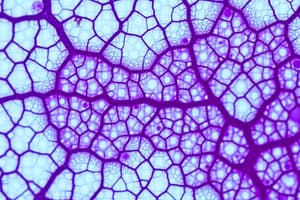Podcast
Questions and Answers
What is the main embryonic form of connective tissue?
What is the main embryonic form of connective tissue?
Mesenchyme
Which of the following are functions of connective tissue? (Select all that apply)
Which of the following are functions of connective tissue? (Select all that apply)
- Cushioning and insulating as fat (correct)
- Transporting as blood (correct)
- Producing energy
- Enclosing and separating as capsules around organs (correct)
The major cells of connective tissue proper are called __________.
The major cells of connective tissue proper are called __________.
fibroblasts
Adipose cells primarily store fat as multiple small droplets.
Adipose cells primarily store fat as multiple small droplets.
What is the main component of the extracellular matrix?
What is the main component of the extracellular matrix?
What type of connective tissue is characterized by a loose, irregular arrangement of cells and fibers?
What type of connective tissue is characterized by a loose, irregular arrangement of cells and fibers?
Match the following connective tissue types with their descriptions:
Match the following connective tissue types with their descriptions:
What type of collagen is most abundant in the human body?
What type of collagen is most abundant in the human body?
Elastic fibers are made from collagen protein.
Elastic fibers are made from collagen protein.
What cells are responsible for producing antibodies?
What cells are responsible for producing antibodies?
The major types of glycosaminoglycans (GAGs) include __________.
The major types of glycosaminoglycans (GAGs) include __________.
Flashcards
Connective Tissue
Connective Tissue
Provides support, connects tissues, and facilitates metabolite diffusion.
Mesenchyme
Mesenchyme
Embryonic connective tissue derived from mesoderm, containing undifferentiated cells in a gel-like matrix.
Functions of Connective Tissue
Functions of Connective Tissue
Encloses and separates organs, connects tissues, supports movement, stores fat, transports nutrients, and protects the body.
Fibroblasts
Fibroblasts
Signup and view all the flashcards
Adipose Cells
Adipose Cells
Signup and view all the flashcards
Macrophages
Macrophages
Signup and view all the flashcards
Mast Cells
Mast Cells
Signup and view all the flashcards
Collagen Fibers
Collagen Fibers
Signup and view all the flashcards
Elastic Fibers
Elastic Fibers
Signup and view all the flashcards
Loose (Areolar) Connective Tissue
Loose (Areolar) Connective Tissue
Signup and view all the flashcards
Ground Substance
Ground Substance
Signup and view all the flashcards
Study Notes
Overview of Connective Tissue
- Provides a matrix for support and connection of other tissues while facilitating metabolite diffusion.
- Primarily composed of extracellular material, rather than cells, forming supportive stroma within organs.
Origin of Connective Tissue
- All adult connective tissues derive from mesenchyme, an embryonic connective tissue with undifferentiated cells in a gel-like matrix.
- Originates from mesoderm.
Characteristics of Connective Tissue
- Abundant throughout the body with a diverse range of functions and structures.
- Composed of various cells and extracellular matrix, allowing for varied roles.
Functions of Connective Tissue
- Encloses and separates organs through capsules.
- Connects tissues with tendons and ligaments.
- Supports movement via bones.
- Stores fat and provides cushioning and insulation.
- Transports nutrients and waste through blood.
- Protects the body with immune system cells.
Types of Connective Tissue Cells
- Resident Cells: Include fibroblasts, myofibroblasts, macrophages, adipocytes, mast cells, lymphocytes, and plasma cells.
- Wandering Cells: Include neutrophils, eosinophils, basophils, and monocytes.
Connective Tissue Cell Functions
- Fibroblasts: Major cells synthesizing collagen, reticular, and elastic fibers, along with ground substance components.
- Fibrocytes: Inactive or resting cells, smaller than fibroblasts.
- Adipose Cells: Store fat primarily as triglycerides; predominant in adipose tissue.
- Macrophages: Engulf debris and pathogens; important for immune response and derived from blood monocytes.
- Lymphocytes and Plasma Cells: Produce antibodies and are key in immune defense.
- Mast Cells: Release histamine in response to allergens, triggering allergic reactions.
Connective Tissue Fibers
- Collagen Fibers: Most prevalent protein in the body, providing strength.
- Reticular Fibers: Form delicate networks and are mainly composed of type III collagen.
- Elastic Fibers: Allow stretching; composed of elastin and found in areas requiring elasticity, such as blood vessels.
Extracellular Matrix Components
- Composed of protein fibers (collagen, reticular, elastic) and ground substance (GAGs, proteoglycans).
- Tissue fluid supports metabolic functions, allowing nutrient and waste diffusion.
Categories of Connective Tissue
- Embryonic Connective Tissue: Includes mesenchyme and mucoid tissue (found in the umbilical cord).
- Adult Connective Tissue:
- Connective Tissue Proper:
- Loose (areolar) tissue with irregular cell and fiber arrangement.
- Dense connective tissue with packed fibers (regular and irregular types) for strength and resistance.
- Specialized Connective Tissue: Includes adipose tissue, elastic tissue, cartilage, bone, and blood.
- Connective Tissue Proper:
Additional Types of Connective Tissue
- Dense Regular Connective Tissue: Organized fibers provide high tensile strength (e.g., tendons and ligaments).
- Dense Irregular Connective Tissue: Randomly oriented fibers for multi-directional strength; found in skin and joint capsules.
- Reticular Tissue: Forms a 3D network supporting cells in lymphoid organs, allowing immune cell access and monitoring.
Ground Substance
- Composed of GAGs (hyaluronic acid), proteoglycans, and glycoproteins; acts as a lubricant and protective barrier.
- Binds with water, helping to regulate fibroblast proliferation and allowing temporary cell attachment.
Tissue Fluid
- Similar to blood plasma; facilitates nutrient and waste diffusion in connective tissue.
- Governed by hydrostatic pressure and colloid osmotic pressure, maintaining fluid balance in capillaries.
Studying That Suits You
Use AI to generate personalized quizzes and flashcards to suit your learning preferences.




